Click the link to download the June 10, 2015 syəcəb:
June 10, 2015
syəcəb
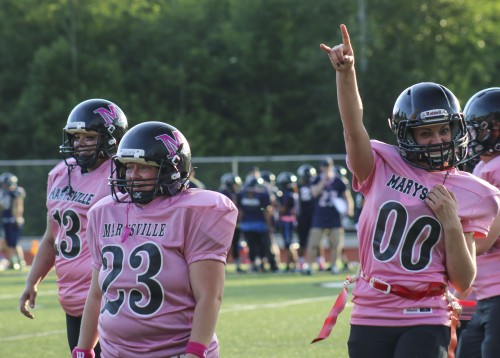
By Brandi N. Montreuil, Tulalip News
MARYSVILLE – They are a team of 31. They are tough. They are proud and they play with heart. They are moms who play football to support their kids. Through a combination of tackle and flag football, called “flackle,’ the Marysville Powderpuff team raises funds for youth in the Marysville Youth Football League through ticket sales. While the goal is to raise money for the kids, these moms say they also play for themselves.
Marysville Powderpuff is comprised of mothers with youth playing football and cheerleading through the MYFL. Ticket sales from each game go to support MYFL through uniforms, protective gear, and travel costs. This year the team boasts three Tulalip tribal members.
Mytyl Hernandez is in her second season. She joined to help support her daughter who cheers through MFYL. But that isn’t her only reason. “I love the competitive aspect of it and being with this amazing group of women a few days a week. I don’t love the bruises, most of the other girls love their bruises but that isn’t my favorite part.”

Team organizer Kym Gallo has been playing since the start and is now in her sixth season. She knows it might be strange to see moms suiting up for practice right along with their kids who are running drills on the opposite side of the field, but says the kids think it’s awesome. And the large ticket sales on game day show people are intrigued to see these moms showcase their skills in one of the fastest growing sport across the nation.
Women’s football is becoming a role model for young women by breaking barriers in traditionally assigned gender sports. More and more girls are joining flag and tackle football teams, such as the professional women’s tackle football team, Everett Reign.
“In the first year we struggled just to get 17 women playing. Now we have 31 on our roster.” Gallo credits this appeal to play football to those early women who were brave enough to break the stereotype of football as a male only sport.
Gallo explains other moms in MYFL and women attending game day who caught the flackle bug quickly signed up to join Powderpuff.
“They see us on game day and they want to try it. Our kids are so proud of us; that just helps boost us up. Each one of these women make you want to come back and be around them, not only are we learning football, we are picking each other up. We are a sisterhood,” said Gallo.

This sisterhood is what drew Tulalip tribal member Veronica Iukes, known as “Wreckingball” on the field, who is playing her first season as a Powderpuff.
“I lost my sister almost two years ago and have had a hard time adapting. I feel like I gained 20 more sisters being on this team. We have created a bond. When one of us is having an off day, everyone is there to pick one another up. They are the strongest mammas I know who will go above and beyond for their kids,” said Iukes, who has two daughters who cheer for MYFL and a son who plays football and encouraged her to start playing this year.
Also a newcomer to this year’s season is Tulalip tribal member Yvonne Williams whose son has played with MYFL for the past six years. Although interested in joining she was unable to find the time until now.
“When suiting up with full gear it’s game time, whether we are in a game or getting in a good practice. We get a glimpse of what our kids do on the field. The real MVPs are these amazing kids,” said Williams.
“These women are doing what mom’s do best, working hard for their kids. I know some younger girls that can’t wait to play for our team,” continued Williams, who hopes her daughter will join her on the field some day.

While the idea of women playing football is still a new concept it has gained popularity as women athletes challenge stereotypes.
“We break the stereotype just by looking at us,” said Hernandez. “We are all different ages and sizes in full gear. We are more than just a bunch of moms. This is a sisterhood. We all want to see each other do our best so it’s a constant stream of encouragement, positivity and helping each other get stronger and better. It’s really quite amazing.”
“I would strongly recommend and encourage all mother, aunts, sisters and guardians of children who participate in MYFL or Marysville Junior Cheer Association to play,” said Clarissa Young-Weiser who played with the team last year. “You have a better understanding of the sport and what your child has to go through when playing. There is no other intensity like football.” An injury this season is preventing Young-Weiser from playing this year. She hopes to return the following season.
Marysville Powderpuff team plays their first game on June 26 at 7 p.m. at the Quil Ceda Stadium at Marysville-Pilchuck High School. You can check out their Facebook page at Marysville Powderpuff Football for more information on tickets and team updates.
Brandi N. Montreuil: 360-913-5402; bmontreuil@tulalipnews.com








by Micheal Rios, Tulalip News
From 9:00 a.m. – 3:00 p.m. on Friday, May 29, Tulalip community volunteers teamed up with the Wisdom Warriors to participate in the Tulalip Health Clinic’s second ‘Grow your own fruits, vegetables and edible flowers’ community event. The volunteers came together at the Tulalip Bay Wellness Garden and Trail to grow food and community.
The Tulalip Health Clinic’s Diabetes Program is determined to teach the tribal membership how to live a healthy lifestyle that minimizes the risk of diabetes and welcomes any and all community volunteers to become a part of the Wellness Garden. Sponsored by the Diabetes Program, volunteers are provided with seeds, plants, apple trees, blueberry bushes, and raspberry vines among various other fruits and vegetables that are then planted in the Wellness Garden. Master gardeners from Washington State University along with local gardening experts were on hand to answer questions and provide useful gardening tips whenever necessary.
“It’s an opportunity for the people to come back and work with the Earth, their cultural lands and restore it,” says Veronica “Roni” Leahy, Diabetes Program Coordinator of the community gardening events. “The land, this place, is what deserves the recognition. We’re just caretakers and we’re doing what we can to take care of it. Just like we do in the Health Clinic. No different from what we are doing for people on the inside of Health Clinic to restore health, we’re doing the same for people and this land on the outside of the Health Clinic.”
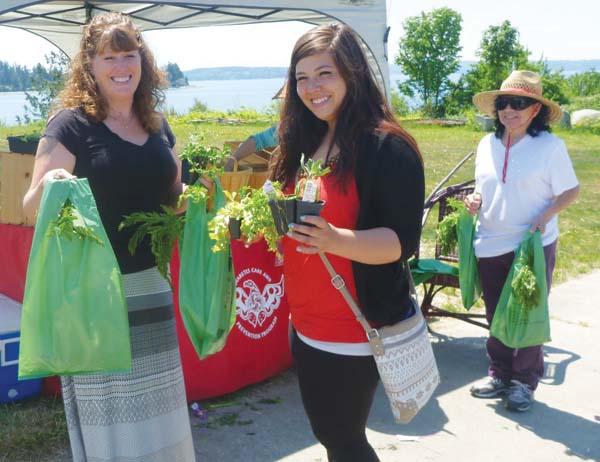
One of the many highlights of the day’s event was the opening of the Wisdom Warrior produce stand. With the assistance of the Diabetes Program, the Wisdom Warriors set up a produce stand on the sidewalk of Totem Beach Road, alongside the Wellness Garden, to give away free organic produce. The purpose of the produce stand is primarily to ensure the produce grown in the Wellness Garden goes out to the community and to give community members a convenient sample to add organic vegetables to their diet
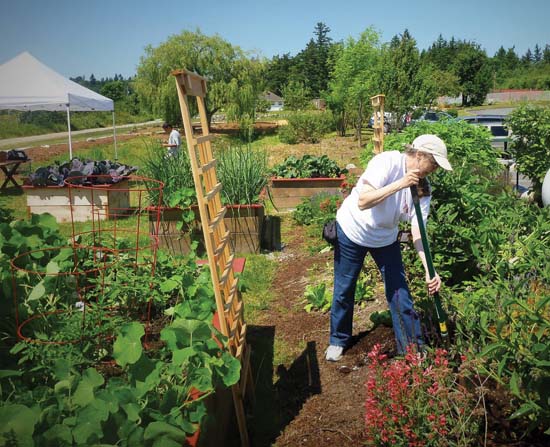
Every person who walked by or drove by and stopped at the produce stand was given a bag of freshly harvested vegetables. Amongst the vegetable bounty were carrots, cucumbers, zucchini, onions, various herbs, kale and lettuce. The kale and lettuce were harvested from the Wellness Garden, while the other vegetables are grown in the Wellness Garden they were not ready to harvest. Instead the not yet ready to harvest vegetables were purchased locally to demonstrate what vegetables are currently being grown.
The Wisdom Warriors estimate they gave away 60+ bags of fresh organic produce to community members.

Contact Micheal Rios, mrios@tualiptribes-nsn.gov
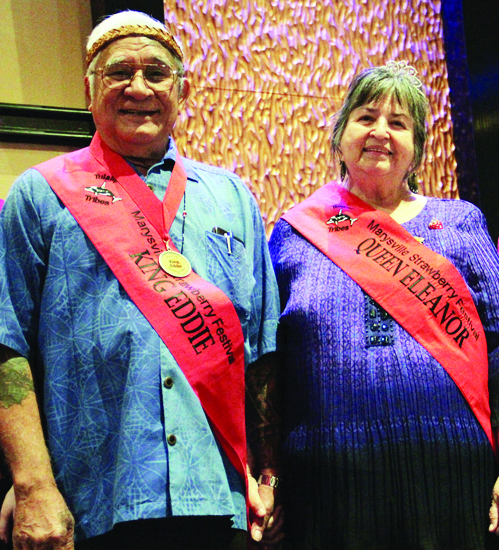
by Mara Hill, Tulalip News
Guests travel from all over to participate in the fun and excitement of the annual Elders Luncheon held at Tulalip. For over eighteen years, the Tulalip Tribes has been hosting these luncheons specifically put together to honor elders and seniors. This year it was hosted on May 28 at the Tulalip Tribes Resort and Casino in the Orca Ballroom. Tribal and non-tribal members from our community and surrounding communities come together, find old friends, visit with family and meet new people.
Not only was this Elders Luncheon a day to honor our elders and seniors, it was also a day to crown the King and Queen for our upcoming Strawberry Festival and parade. Each year at least one Tulalip tribal elder is chosen to represent the Tulalip Tribes and the senior community. This year Eleanor Nielsen, a Tulalip tribal member, and her husband Eddie were crowned by the Marysville Strawberry Festival Senior and Junior Royalty.
Eleanor said that she is “proud to be a member of the Tulalip Tribes and to be chosen Queen, representing Tulalip and the Marysville Strawberry Festival.”
Eleanor and Eddie have attended the elders luncheons many times. “It is good to be with family and friends from many tribes. We like sharing the day with everyone,” said Eleanor.
“I am happy to be in the parade and thankful to Tulalip Tribes”, said Eddie.

The luncheon included a raffle, which totaled $1500 in cash prize giveaways. There were ten $100 winners and ten $50 dollar winners along with several others who received gift baskets that were donated by tribal departments. In addition to the raffles, students from Tulalip Heritage High School honored the elders and seniors by gifting a blanket to the eldest member at each table.
Tina Brown, Athletic Coordinator at Heritage said “I have been bringing students the past five years to help honor our elders from all over the different reservations and tribes.”
Local and non-local vendors were on hand selling Native crafts and food. Some of the artwork included authentic handmade cedar weaved baskets made by Tulalip Tribal veteran, David Fryberg Sr. Fryberg has been cedar weaving for about 10-15 years and has been vending for approximately 20 years.
Vendors Percy and Ida Kanesta, a couple from Tacoma, have been selling their authentic handmade Native Zuni jewelry at the elder luncheons for almost 15 years and have been hand-making family oriented jewelry for nearly 50 years. Some of the jewelry they make is created out of turquoise, black onyx, silver, lapis, and malachite.
Jimi Pablo a Tulalip tribal member is a first-time vendor at the luncheon but has been in the vending business over 34 years. Pablo was selling fresh, handmade yeast bread. He explained that he had started making the bread at 4:30 p.m. the day before the luncheon and didn’t finish until 4:30 a.m. that day.
Wrapping up the 50’s inspired event were rounds of singing and possibly even a poodle skirt twirl or two.
Contact Mara Hill, mward@tulaliptribes-nsn.gov
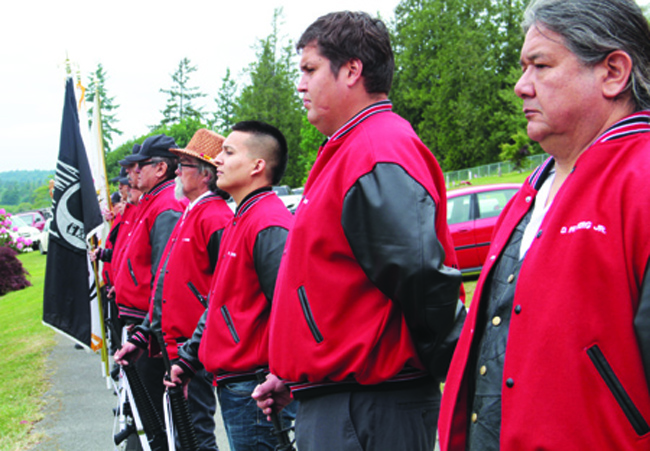
by Mara Hill, Tulalip News
The significance of Memorial Day is much more than taking an extended vacation or having a barbecue in your back yard on a nice hot, sunny day. It is a day to honor the men and women of the United States Armed Forces who dedicated their lives to our country by paying the ultimate sacrifice. It is one of the few days that veterans are recognized, and one of the more important holidays. Speaking as a veteran, I understand the importance of this day. It is a day of remembrance, honor, and a way to express gratitude and thanks to the families of these service members.
These service members are just like any other person, aside from the fact that they joined a branch of the military in order to become something bigger than themselves. Many men and women who have served in any era that return from war and live to share their stories, come home incomplete; leaving behind a part of themself. Some return with mental health problems, post-traumatic stress disorder, night terrors, traumatic brain injuries, survivor’s remorse, shrapnel injuries, and external and internal scars.
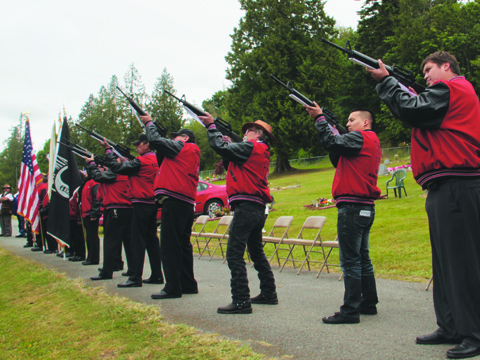
Among the several people that arrived to pay respect and memorialize fallen family members were Tulalip Tribal Chairman Mel Sheldon. Sheldon welcomed and thanked people for attending, and introduced tribal member Virginia Jones who opened up the ceremony with a prayer in Lushootseed. Retired United States Marine Gunnery Sgt. Cyrus “Cy” Hatch III, held roll call for all fallen and present service members.
To conclude the ceremony, The Tulalip Tribes Honor Guard fired a 21-gun salute, and performed “Taps” to pay respect and honor over 200 fallen Tulalip Tribal member veterans who have lost their lives.
The ceremonies were held at the Priest Point Cemetery at 10:00 a.m. and the Mission Beach Cemetery at 11:00 a.m. on Monday, May 25 2015.
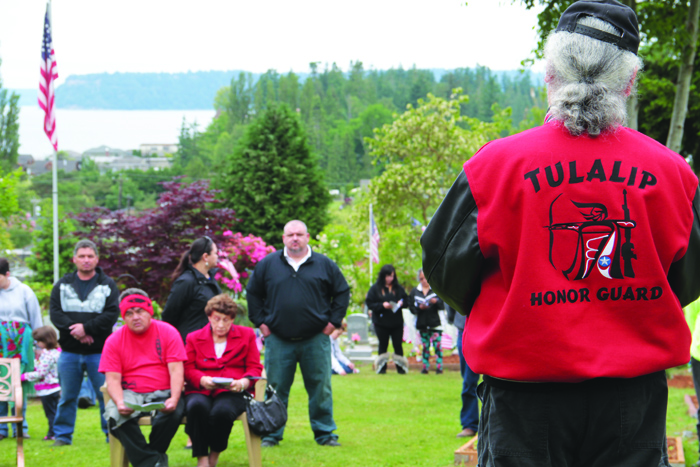
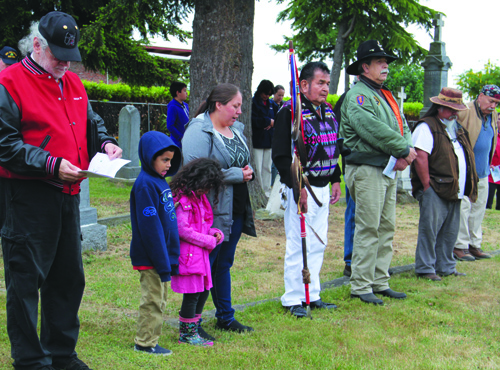
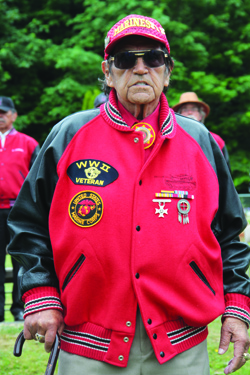
Contact Mara Hill, mward@tulaliptribes-nsn.gov
By Micheal Rios, Tulalip News


As part of the 2015 7th Generation Mentoring program, Tulalip Tribes held the High School Junior Nationals Basketball Tournament over the weekend of May 16 and 17. The two-day tournament, featuring a boy’s bracket and girl’s bracket, brought out some of the best Native high school teams in the Northwest. The Lummi Blackhawks, Washington State Champions, the Lapwai Wildcates, Idaho State 2nd place team, and Tulalip’s own Young Gunz team, featuring Robert Miles Jr. and Bryce Juneau, were expected to be the contenders battling it out for tournament champion. On the girl’s side, it was just a matter of time before Tulalip’s team featuring Adiya Jones and Faye Chartraw would be playing Idaha State Champions, the Lapwai Wildcats, in the finals.
It’s worth noting that there were several teams who came from out of state to participate in the basketball tournament. Besides the boys and girls teams from Lapwai, Idaha (of the Nez Pierce), there was also a boys team from Wyoming and a girls team from Nevada who traveled the long distance to represent for their tribe and state.
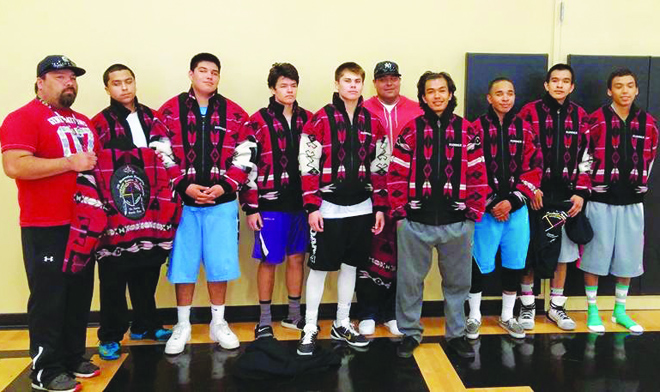
The boys Championship game featured the Tulalip Young Gunz vs. the Lapwai Wildcats. The Young Gunz got off to a terrible start and were unable to break the full-court press applied by the Wildcats. A little more than midway through the 1st half the Young Gunz found themselves trailing 12-27, and at halftime they were down 19-30. In the 2nd half, the Wildcats went out of their full-court defense and that allowed the Young Gunz to mount a bit of a comeback, getting with 6 points, 48-54 with 4:00 left to play. The Wildcats were just better at executing their offence and seemed to force turnovers at will, which ultimately won them the game and the tournament.

The girls Championship game also featured a Tulalip vs. Lapwai Wildcats matchup. The Tulalip team, coached by Charlotte Jones, did their best to keep up with the State Champions from Idaho, but the speed and tempo of the game favored the Lady Wildcats. In the end, the Lady Wildcats won the game, resulting in a Lapwai sweep of both the boys and girls brackets. Tulalip represented and took 2nd place in both sides of the bracket.
Lonne Enick, tournament coordinator, said of the weekend’s basketball festivities, “Another successful tournament in Tulalip. Thank you to all the people for coming out and supporting their teams.”

BOYS Division:
1st – NimiiPuu Elite (Lapwat, ID)
2nd – Young Gunz (Tulalip, WA)
3rd – Blackhawks (Lummi,WA)
GIRLS Division:
1st – Lapwai Wildcats (Lapwai, ID)
2nd – Tulalip Elite (Tulalip, WA)
3rd – Nevada BallHogs
Contact Micheal Rios, mrios@tulaliptribes-nsn.gov
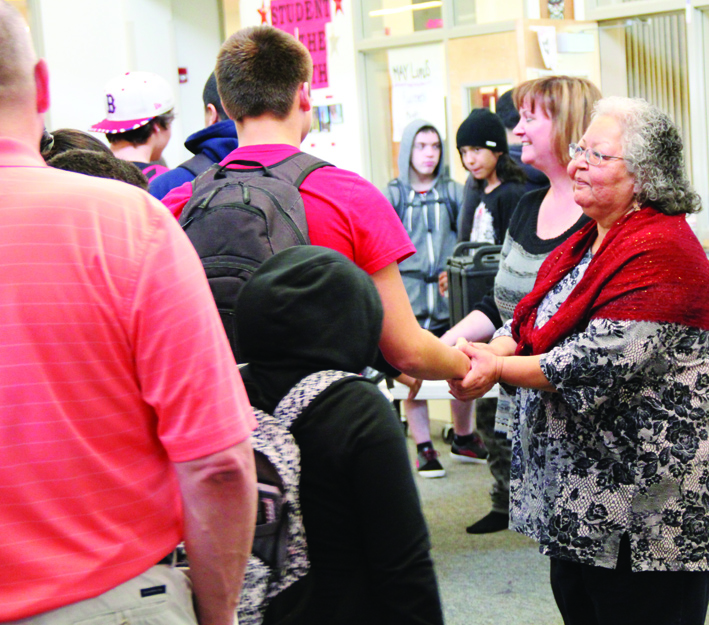
by Micheal Rios, Tulalip News
On Thursday, May 14, the students of Heritage High School received a special in-person recognition by Inez Bill, Rediscovery Coordinator, for their efforts in cleaning up the natural history preserve located behind the Hibulb Cultural Center on Earth Day. All the Heritage students assembled in the main hall of the high school, received a traditional refreshment (nettle tea), and were recognized by a deeply appreciative tribal elder.
“You’re investing in your own future. It’s you young people that will come up after me and will take care of the museum and take care of the natural history preserve for the future generations, for your children’s children’s children,” said Bill to the Heritage students as they stood attentively around her. “That’s what our ancestors said when they signed the treaties. We wanted to preserve the rights of our people for their children’s children’s children. Today, this is where we are. You’re the ones that our ancestors talked about, they talked about this. It’s up to you to take care of this land, to carry on the teachings and values of our people. You will be the caretaker of our culture and our land….the beliefs, the respect, the honor.
“In doing what you did, you made a contribution to your own future. And so I wanted to acknowledge all those who came to Hibulb and invested in their future because I wasn’t there at the time and that’s the reason why I’m here today. Because I do need to acknowledge that because we can’t let something like that go by and not say thank you, take time and say thank you. I wanted to acknowledge that because you are important to your teachers and your teachers are important to you. That’s the way of our people. All of this is going to mean a lot to you later. I am a person who has had many teachers in my life and have teachers even today who continue to teach me. I am nothing without my teachers. I am nothing without having them people in my life. I appreciate the people who take the time; who teach me how to be a good person and live in a good way. Remember to honor your teachers because in our way of life we will have many teachers.
“Remember to take care of our environment. We’re at a critical time in our lives where our water is polluted, where there are a lot of things going on that are taking up the land, things are happening to our Mother Earth. It’s going to be up to you to help save our environment, to help save the purity of our water. Water is sacred. Everything that is living requires clean water, whether it’s salt water or fresh water, for the salmon and the fish and all Mother Earth.
“I just wanted to come here and share that with you today. Thank you. Try to be good stewards of the Earth 365 days of the year, like our ancestors were. Try to think about it and keep it in your prayers. Thank you.”
Contact Micheal Rios, mrios@tulaliptribes-nsn.gov
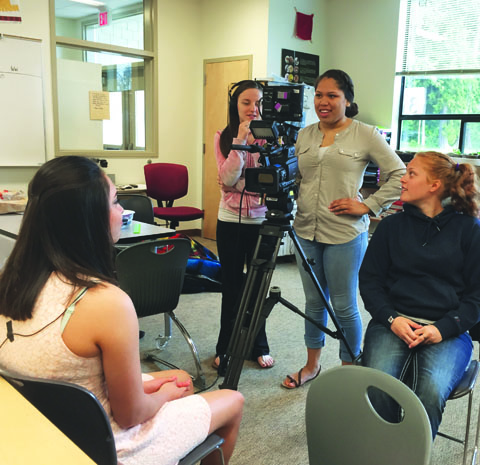
by Mara Hill, Tulalip News
Students at Tulalip Heritage High School were given the opportunity to experience different types of art in a program called Artists in Residency (AIR). Eight artists from the area came to the school to instruct students in a fourteen-week course, giving each student an option to learn, create, and perform two different types of art. The art classes offered were cedar weaving, carving, yoga, pow wow 101, Native American flute making/playing and video production. The teachings from each instructor allowed students a hands-on and individualized experience.
Shelly Lacy, the principal at Heritage, explained that the students not only learn the craft that the artist is sharing, but they learn traditional teachings as well.
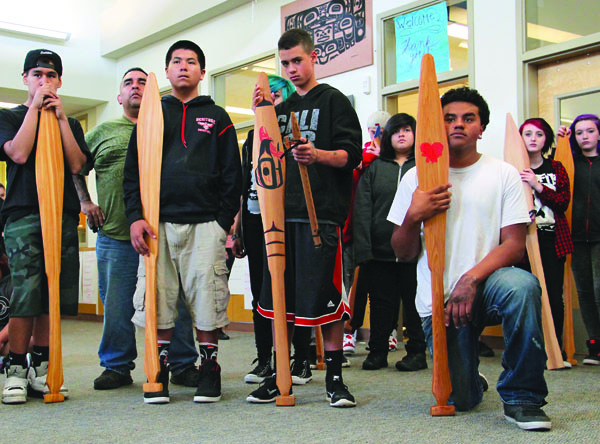
The video production class, instructed by Brian Berry and Rick Valentine, video producers from the Tulalip Tribes Communications Department, introduced students to the basics of video production and film making and then progressed into some of the more technical aspects. Students learned about framing, lighting, b-roll, audio, and editing. They were also taught how to interview people and operate a high definition video camera.
Nina Fryberg, a senior at Heritage, talked about why she chose video production. “At first I decided to take yoga and cedar weaving, but I asked to switch into film-making for both periods instead.” Fryberg had experience working on a short-film last year in another program, which helped with her decision to participate in video production this year. She also earned a position as a student producer, which allowed her to give other students instructions and tell them which crew positions they were assigned to.
Berry explains that students weren’t selected as producers, but that they more or less “earn the position by showing a significant level of initiative and attention.” Student producers also run the productions and make editing decisions.
“It takes a lot of effort to put into film-making. You have to plan everything out and make sure everything is okay and ready to go before you start filming” said Fryberg.
In the final weeks, students in each class finished their projects and prepared to perform for the other students, instructors and faculty members. The video production class created a short film, “Heritage High School – A Small Learning Community” which previewed on May 15th, about what makes Tulalip Heritage High School unique and why students chose Heritage over other schools in the district. The video was a product of what the students learned over the course of 14 weeks.
“The student body, faculty and fellow AIR artists screened the video and it received a round of applause and cheers” said Berry.
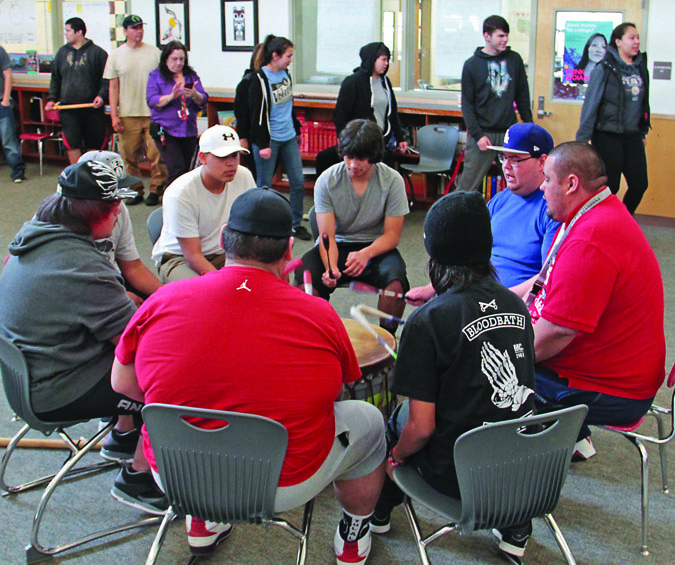
The six additional artists who shared their gifts, teachings, knowledge, and talent with the students were Clarissa Johnny, Kelly Moses, Mytyl Hernandez, Ian LaFontaine, Sheri Thunder Hawk and Paul Wagner.
“Heritage High School – A Small Learning Community”can be watched on demand at tulaliptv.com and found in the Tulalip Culture section of the main menu.
The video will also be included in the May 25th edition of Tulalip Matters, which will air daily for a week, beginning May 25, on Tulalip TV channel 99, at 12: a.m., 8:00 a.m., 12:00 p.m., and 5:00 p.m.
Tulalip Matters can also be viewed anytime, on demand, at tulaliptv.com.
Contact Mara Hill, mhill@tulaliptribes-nsn.gov